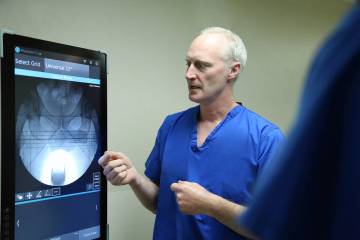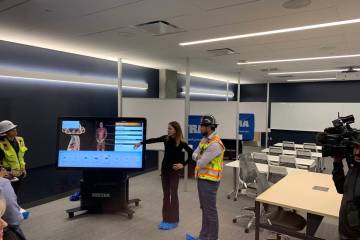Dr. Andrew Cash is bringing new surgical procedures to market in Southern Nevada that will help his back patients return to pain-free life.
Cash, a spine surgeon who has been operating in Las Vegas for seven years at the Desert Institute of Spine Care, was the first surgeon to perform the oblique lumbar interbody fusion, or OLIF.
Although he wasn’t the first to market the sacroiliac joint fusion procedure, he is one of the first surgeons to perform it using the minimally invasive iFuse Implant System. He performs these hourlong, outpatient procedures at the Minimally Invasive Spine Institute, which Cash founded specifically for minimally invasive procedures.
Cash added that the advantage of these procedures is they are less invasive than traditional open surgery, meaning:
▶ Minimal soft tissue disruption.
▶ Minimal incision size.
▶ Minimal tendon irritation.
▶ And decreased length of hospital stay.
“I’m only one of three people approved by the manufacturer to actually teach this, which I have done on a domestic and international basis for multiple surgeons,” Cash said. “It’s the most minimally invasive, smallest incision, least traumatic, most efficient way to remove the disc and provide a fusion.
“As far as the SI joint procedure, there are only a few people in town that have performed this. The technique is going to open the incision 3 to 5 inches, and I’ve got it down to 1 inch. … There’s no way to improve the incision and the efficiency of tissue damage from my technique.”
Thanks to Cash’s expertise with the sacroiliac surgery, his patients have again been able to walk without pain.
One of his patients, Ruth Peoples, injured her back while working at a military base in California. Before she moved to Las Vegas and started seeing Cash, she had 14 prior surgeries that did nothing to correct her medical issues.
“The doctor who was treating me at first did a procedure called a discogram, and it set up a staph infection in my spine,” she said. “So that started the surgery and fusions, because it did so much damage. I had to be fused from L2 to L5-S1, and it led up to 14 surgeries and it didn’t help. Each surgery was a failure, and the pain got worse. My leg just never stopped hurting.
“It got worse and they thought it was a sciatic nerve and so anything they’d done, it didn’t help at all. So, I moved from California to Las Vegas, and by the grace of God, I got Dr. Cash as a doctor. I’ve had so many surgeries in California, so many different treatments and so many different antibiotics therapy, and when I got with him we couldn’t figure out what to do. By then I didn’t have any faith in anything. So whatever Dr. Cash recommended, I shot it down for almost two years.”
Initially, Cash wanted to try a spinal cord stimulator for Peoples’ injuries.
“Fortunately, Ruth opted not to go with the stimulator,” Cash said. “Over those two years, I was still investigating the technology of the SI joint procedure. I was aware of it, but I hadn’t been demonstrated the effectiveness and I didn’t want to experiment on anyone. So, I waited until about the two-year mark of the procedure’s availability and decided I would be an early adapter because I had done so much research on the procedure with other doctors and other centers where they performed this surgery.
“I’d say Ruth is lucky that she didn’t go with the stimulator because the stimulator has shortcomings. There is no guarantee it will work. It involves the risk of general anesthesia and undergoing a procedure. … If you had like a traumatic injury and needed an MRI, you cannot have it because of the stimulator so it precludes maybe some proper treatment in the future.”
Peoples’ surgery, on Sept. 6, was a success. After the operation, she had to relearn to walk. She used a walker for three weeks, then used a cane. Now she is walking fine, Cash said.
The desire to get patients get back to living full lives drives Cash’s push to improve orthopedics.
“I found orthopedics to be very challenging to help people get better, and you can actually, with the technology and orthopedics in general, make people better immediately,” Cash said. “However, I thought the biggest challenge would be presented by spine surgery, which is a little bit behind, more in its infancy, compared to some of the joint replacements and orthopedics in general. But the technology out there has been revolutionary, including stem cells, the minimally invasive OLIF procedure, and now the most revolutionary and exciting thing is the SI joint procedure.
“Ruth is a remarkable testimony on how well it can improve people’s lives with such a minimally invasive surgery. … Fortunately this new technology was able to give her a new lease on life.”






